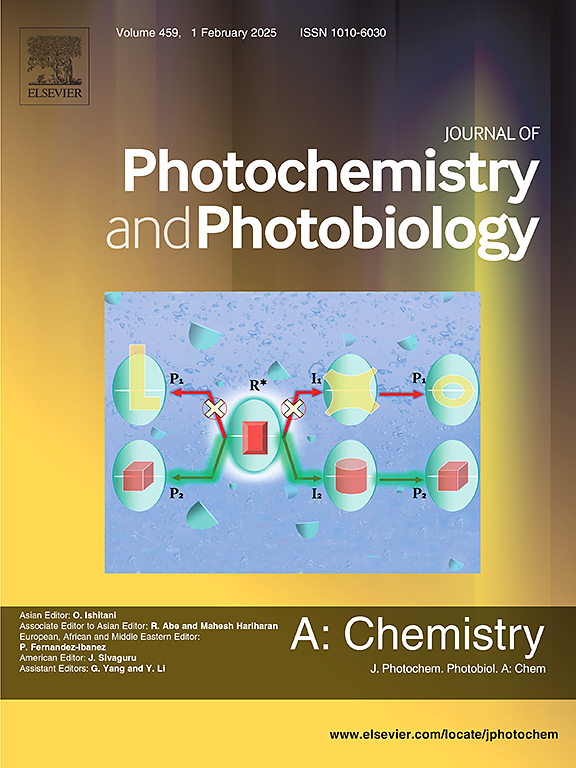Hydrogen-bonding locked phenanthro[9,10-d]imidazole-anthracene emitter enables high-luminance blue OLEDs with low efficiency roll-off
IF 4.7
3区 化学
Q2 CHEMISTRY, PHYSICAL
Journal of Photochemistry and Photobiology A-chemistry
Pub Date : 2025-06-02
DOI:10.1016/j.jphotochem.2025.116539
引用次数: 0
Abstract
In this work, we report the rational design and synthesis of a novel deep-blue emitter, 2-(6-(10-(naphthalen-2-yl)anthracen-9-yl)pyridin-3-yl)-1-phenyl-1H-phenanthro[9,10-d]imidazole (mPANNA), leveraging the synergistic integration of phenanthro[9,10-d]imidazole and anthracene as luminescent units, pyridine as a π-bridge, and naphthalene as a peripheral group. Theoretical calculations revealed that mPANNA exhibits a locally excited-dominated character in its frontier molecular orbitals, which is crucial for achieving high radiative transition efficiency. Single-crystal X-ray diffraction analysis demonstrated a non-planar molecular configuration, where intramolecular hydrogen bonds effectively restrict molecular rotation, enhancing structural rigidity despite the increased distortion from the naphthalene group. Photophysical characterization showed high photoluminescence quantum yields (PLQYs) of 73 % in tetrahydrofuran and 50 % in pure film, highlighting its potential for efficient emission. Electroluminescence performance studies revealed that non-doped device based on mPANNA achieved a remarkable luminance of 41,300 cd m−2, while doped device exhibited a maximum external quantum efficiency of 4.70 % with low efficiency roll-off. Notably, the doped device displayed pure blue emission with an electroluminescence peak at 455 nm and CIE coordinates of (0.172, 0.183), strictly meeting the requirements for high-performance blue OLEDs. This work demonstrates a promising strategy for designing efficient pure blue emitters through molecular engineering and hydrogen-bonding stabilization, paving the way for advanced OLEDs applications.

氢键锁定的菲[9,10-d]咪唑-蒽发射器可以实现低效率滚转的高亮度蓝色oled
在这项工作中,我们报道了合理设计和合成了一种新型的深蓝色发射体,2-(6-(10-(萘-2-基)蒽-9-基)吡啶-3-基)-1-苯基- 1h -菲菲[9,10-d]咪唑(mPANNA),利用菲菲[9,10-d]咪唑和蒽作为发光单元,吡啶作为π桥,萘作为外围基团协同整合。理论计算表明,mPANNA在其前沿分子轨道上表现出局部激发主导的特征,这是实现高辐射跃迁效率的关键。单晶x射线衍射分析显示了非平面分子构型,其中分子内氢键有效地限制了分子旋转,增强了结构刚性,尽管萘基增加了扭曲。光物理表征表明,在四氢呋喃和纯膜中,光致发光量子产率分别为73%和50%,突出了其高效发射的潜力。电致发光性能研究表明,基于mPANNA的非掺杂器件获得了41,300 cd m−2的显着亮度,而掺杂器件的最大外量子效率为4.70%,效率滚降低。值得注意的是,掺杂器件显示出纯蓝色发光,电致发光峰位于455 nm处,CIE坐标为(0.172,0.183),严格满足高性能蓝色oled的要求。这项工作展示了通过分子工程和氢键稳定设计高效纯蓝色发射器的有前途的策略,为先进的oled应用铺平了道路。
本文章由计算机程序翻译,如有差异,请以英文原文为准。
求助全文
约1分钟内获得全文
求助全文
来源期刊
CiteScore
7.90
自引率
7.00%
发文量
580
审稿时长
48 days
期刊介绍:
JPPA publishes the results of fundamental studies on all aspects of chemical phenomena induced by interactions between light and molecules/matter of all kinds.
All systems capable of being described at the molecular or integrated multimolecular level are appropriate for the journal. This includes all molecular chemical species as well as biomolecular, supramolecular, polymer and other macromolecular systems, as well as solid state photochemistry. In addition, the journal publishes studies of semiconductor and other photoactive organic and inorganic materials, photocatalysis (organic, inorganic, supramolecular and superconductor).
The scope includes condensed and gas phase photochemistry, as well as synchrotron radiation chemistry. A broad range of processes and techniques in photochemistry are covered such as light induced energy, electron and proton transfer; nonlinear photochemical behavior; mechanistic investigation of photochemical reactions and identification of the products of photochemical reactions; quantum yield determinations and measurements of rate constants for primary and secondary photochemical processes; steady-state and time-resolved emission, ultrafast spectroscopic methods, single molecule spectroscopy, time resolved X-ray diffraction, luminescence microscopy, and scattering spectroscopy applied to photochemistry. Papers in emerging and applied areas such as luminescent sensors, electroluminescence, solar energy conversion, atmospheric photochemistry, environmental remediation, and related photocatalytic chemistry are also welcome.

 求助内容:
求助内容: 应助结果提醒方式:
应助结果提醒方式:


